Supermicro was one of the first server manufacturers to produce AMD EPYC 7001 series servers. With the 2nd generation AMD EPYC 7002 series, Supermicro is extending that leadership capability to new form factors. At STH, you already saw the topology of one of the company’s new WIO AMD EPYC 7002 products in our main launch piece. There are a number of innovative designs we previewed and got to see in-person during the launch event as well. The new AMD EPYC 7002 parts are ahead of Intel kicking off the company’s 12th generation products.
AMD First to Supermicro 12th Generation Platforms
The first digit in a Supermicro motherboard SKU is usually for a family name. For AMD, this is H. The second digit set is the generation number. Current Intel Xeon Scalable designs, like the Supermicro X11DPi-N are considered the company’s 11th generation products. For AMD, the newest EPYC 7002 motherboards are the Supermicro H12 series. The 12th generation products we expect to have PCIe Gen4, a feature Intel currently lacks on public SKUs. This article’s cover image is of a Supermicro H12SSW-NT motherboard we are reviewing.
Supermicro WIO H12 Generation Servers
Supermicro has two WIO H12 generation 1U servers at launch. The first is a 4x 3.5″ chassis that can handle the front drive bays being used as NVMe bays as well. The second is a 10x 2.5″ SATA drive bay chassis with two that can be used as NVMe.
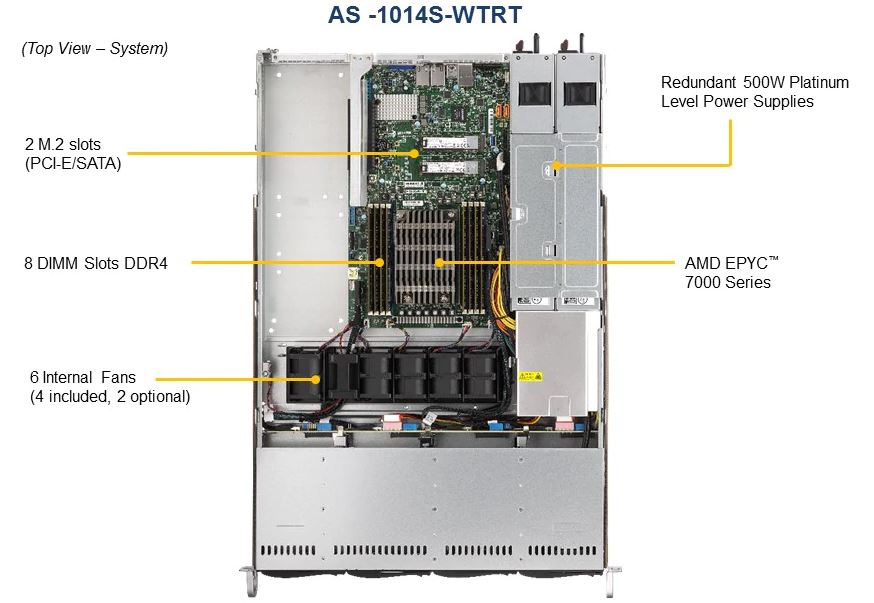
One of the key features of the WIO motherboard is its more modern design. If you look at the H12SSW-NT motherboard itself that powers the new systems, it utilizes a PCIe Gen4 riser solutions for the rear I/O and standard PCIe Gen4 M.2 ports for motherboard attached storage.
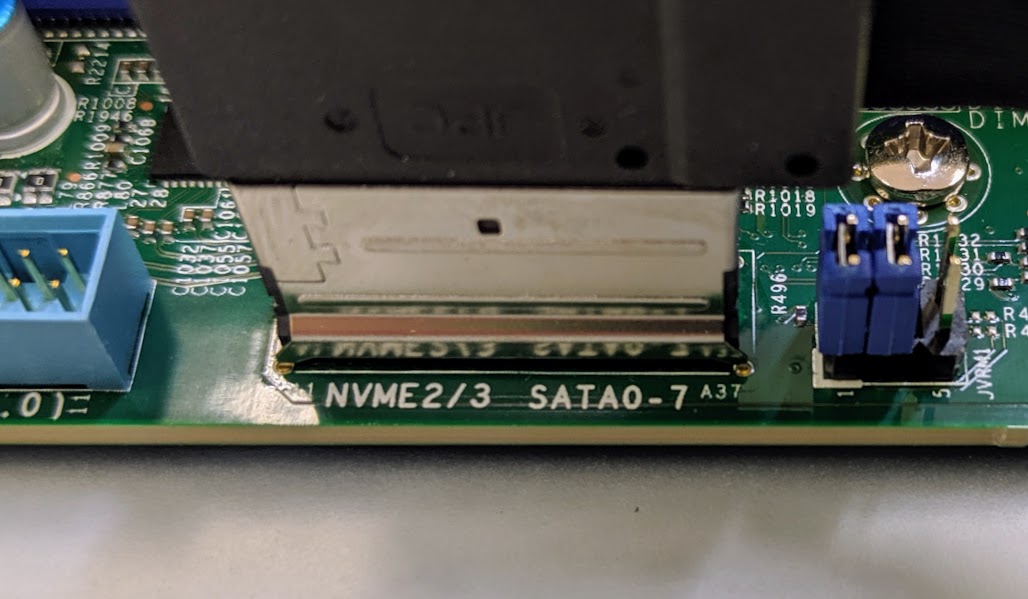
Beyond that, there is an array of PCIe Gen4 cabled ports that can be used for front panel NVMe or other devices. As PCIe signaling speeds increase, and features like serial attached memory become more common, we expect to see motherboards with many cabled device headers.
Revolutionary Supermicro TwinPro 2U4N 1P Server
Supermicro has something out today that has the potential to be a game-changer. The Supermicro TwinPro 2014TP-HTR is a 2U 4-node server with a twist. While most 2U4N designs, like the company’s BigTwin, are dual-socket, the 2014TP-HTR is a single socket per node design.
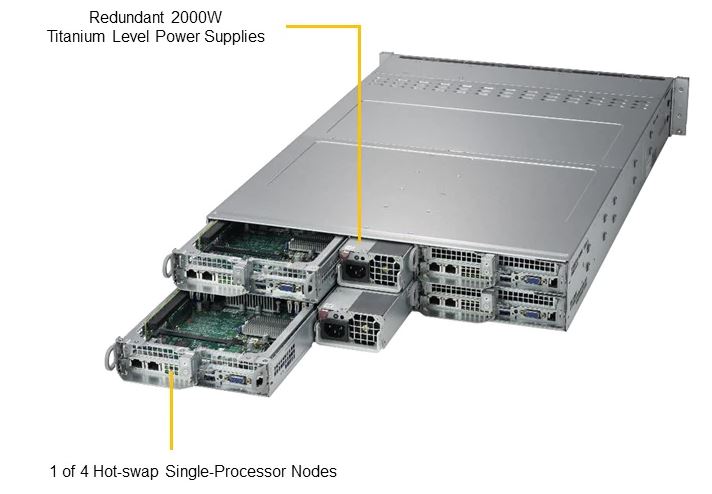
With 12x 3.5″ drives in front (3x per node), the 2014TP-HTR has basic capacity storage covered. Additionally, there are four M.2 NVMe SSD slots for up to M.2 22110 (110mm) SSDs. That means one can use PLP data center M.2 read focused drives or even Intel Optane drives like the Intel Optane 905P 380GB M.2 NVMe SSD or Intel Optane DC P4801X Review 100GB M.2 NVMe SSD Log Option for write-heavy designs. Most dual-socket nodes have 1-2 M.2 SSDs at most but removing a socket means there is more capability. Plus, one has two PCIe Gen4 x16 slots for additional NVMe or 100GbE adapters and a SIOM slot for networking.
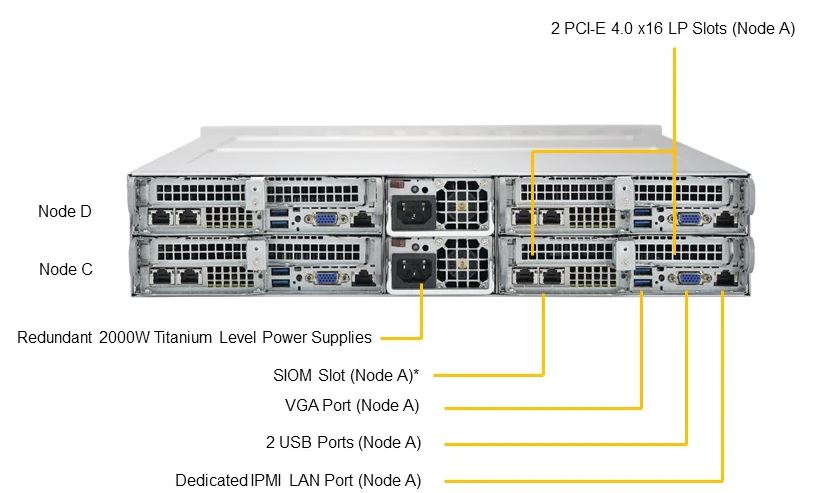
The Supermicro 2014TP-HTR with a single CPU is able to offer core counts (64) and PCIe expansion that was previously only possible with dual-socket servers lower-cost 2U4N 1P design. For data centers, it means that the solution can offer the same node density as Intel Xeon Scalable platforms but at around half the power consumption and half the sockets. That creates new market opportunities for 2U4N designs to increase node density in lower power density racks.
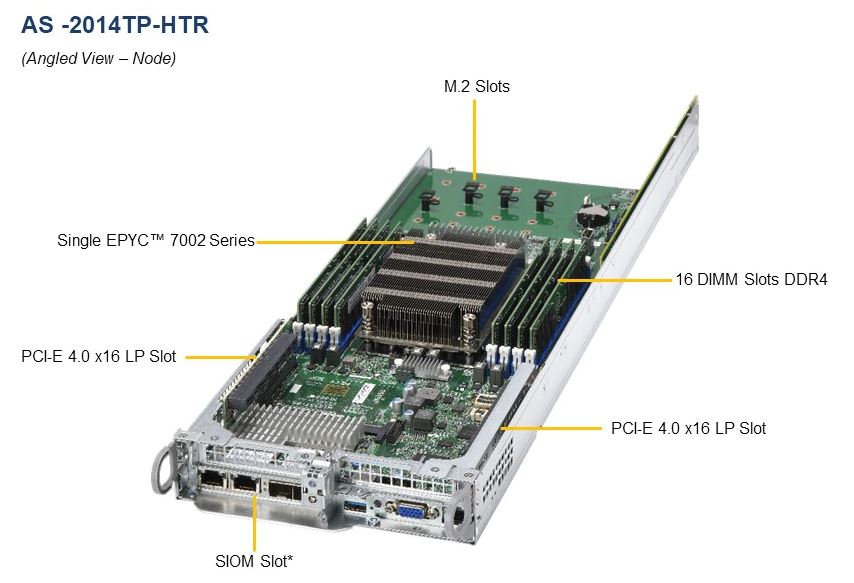
We think this has the potential to be a huge win in the market because it directly addresses the key value drivers of the AMD EPYC 7002 series.
Supermicro BigTwin AMD EPYC 7002 2P Servers
The Supermicro BigTwin has also been updated to support the second generation AMD EPYC 7002 CPUs. This is a more traditional 2U4N design with dual-socket nodes.
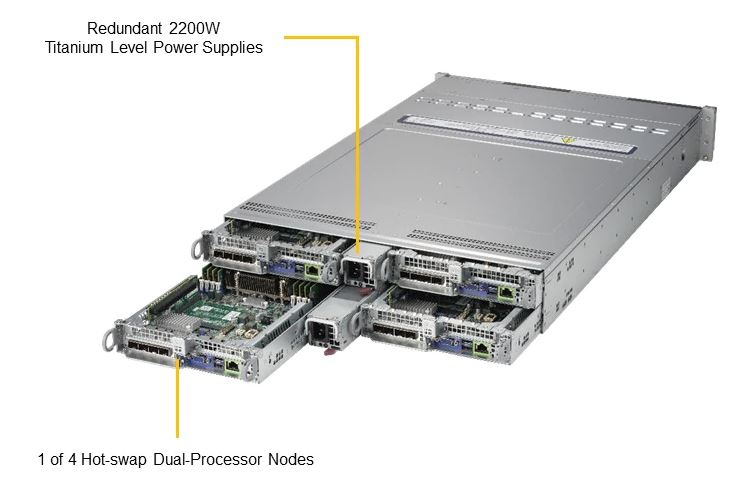
A key benefit here is that by using the AMD EPYC 7002 series, Supermicro can fit up to 512 cores and 1024 threads in a 2U chassis. Using high-end 28 cores, Intel Xeon 8276L CPUs at $16.6K each, we were able to only fit 224 cores and 448 threads into the Xeon based Supermicro BigTwin SYS-2029BZ-HNR we reviewed.
Final Words
We have a feeling this initial Supermicro AMD EPYC 7002 solution salvo will not be the last in this generation. We expect that Supermicro will release a number of newer solutions to take full advantage of the greater PCIe Gen4 capabilities that the EPYC platform offers. Stay tuned to STH for more coverage.

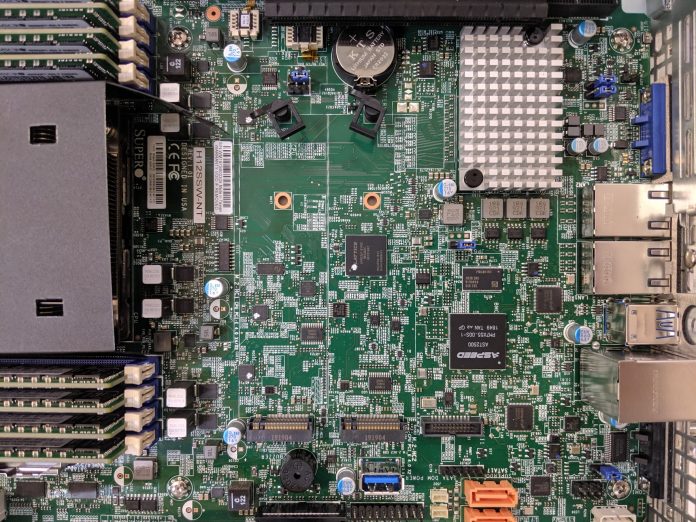



No Ruler or M3 designs from SuperMicro with an AMD Rome at the core?
Gigabyte have also release some new servers for the 7002; hopefully STH will be reviewing these shortly?
:) https://www.servethehome.com/gigabyte-amd-epyc-7002-launch-line-unrivaled-in-scope/
@Chris they posted this earlier https://www.servethehome.com/gigabyte-amd-epyc-7002-launch-line-unrivaled-in-scope/
Patrick, do you have any info about the H11 motherboards? The Supermicro press release states “drop-in support for board rev 2.x” and “this provides new and existing customers on the H11 gen systems a fast upgrade track”. So it seems you get this “update track” only for board rev 2.x. Since when is this board revision on the market? What about customers with older board revisions? Do you have any insight?
A 2U4N uniprocessor system is very nice, but unfortunately the Supermicro AS 2014TP HTR Node has just 8 DIMMs. With 6x U2 NVMe drives pr. node and 16 DIMM slots the 2U4N form factor would be excellent.
I just want to know which server manufacturer is going to go whole hog using the new EPYC platforms for deep learning systems. A 2 socket system with 160 PCIe 4 lanes can feed more dual slot accelerators than a 2U box can even hold. If you go to single slot cards, you have to go to 8 PCIe 3.0 lanes (behind a switch obviously) to hit 24 of them on one board, but for inference that should be fine. I’m imagining a server with 24 nVidia T4s and 2, 7742 EPYC chips, along with dual 100GbE/EDR.
@Patrick
“BIOS R2.0 only support MB Rev2.00 with 32MB SPI flash ROM to support both AMD 7001/7002 series processors”
a) Does this mean only R2.00 supports EPYC 2 or
b) Even EPYC <Rev.2.00 supports EPYC 2 but then not EPYC 1 since the ROM is to small?
And; is there a possibility to switch the BIOS chips since it is not soldered?
I can answer my post: EPYC 2 is only supported with Rev2.00 boards.
I count 8 not 16 DIMM slots per node (the image says 16 in the text). Is it 8 or 16?
JB it is 8. That is a typo in the SM image.
Hi, for example the https://www.supermicro.com/en/products/motherboard/H11SSL-i have a BIOS Type AMI 128Mb SPI Flash EEPROM. Since when is on market the rev 2.00 board? thanks
Patrick, can you perhaps reach out to your Supermicro contact to clarify the situation for H11 boards? Supermicro claims in their press release that there is an upgrade path for existing customer („investment protection“). But EPYC Rome seems only to work on rev 2 H11 boards, which are not even out, as far as I can see. So how can existing customers upgrade?
Interesting platform. I hope we’ll soon see the whole lineup of H12 boards, I’m looking for something to replace my Xeon server at home.
https://www.youtube.com/watch?v=HzmIyzRVl1A
Dwight Looi from Supermicro talk about current H11 boards (current supports EPYC Rome processors)
I was now told from a big vendor that boards with rev < 2 will definitely not support EPYC Rome, since the BIOS with (128 Mb = 16 MB) is indeed too small to support both Naples and Rome. And the bios is soldered on.
So since rev 2 boards are not out yet, Supermicro still needs to explain their "upgrade path for existing customers"!
@martin, could you provide a time in the video when they talk about H11? Don`t want to go through the whole thing. Thanks!
The single socket board in this video is an H11SSL and a Epyc 7002 series
Min 0:40 “We actually have 8 different boards in production that takes the Epyc 7002 series or codenamed Rome before the launch…”
In this video, the displayed boards have the Rev1.01 ==> I was also told directly by SM that Rome will only be supported by Rev2.0 or higher.
Perhaps they show rev 1.01 boards in the video (rev 2 seems not to exist yet!), but are they working? I guess no.
„8 different boards in production“: Sure, rev 2 is „in production“. But there is nothing out there, in the hands of customers, compatible with Rome. Existing H11 systems are not upgradeable, according to my sources. Supermicro might have to revise their press release („upgrade track for existing customers“).
Here in the UK, I contacted Supermicro’s sales office a few days ago to ask about the availability of rev2 H11SSL boards. They told me that the boards will be available for ordering this week, and gave me a list of their distributors. I reached out to one local distributor, and was able to make an order of the board with one of their resellers. I was told that I should receive the board within 10 working days. So for those who are looking for the rev2 boards, it might be worth contacting the Supermicro sales office or distributors in your region. They have been very helpful in my case.